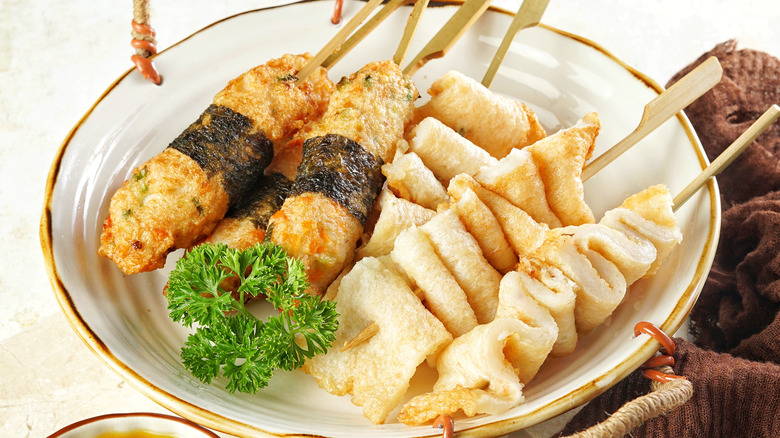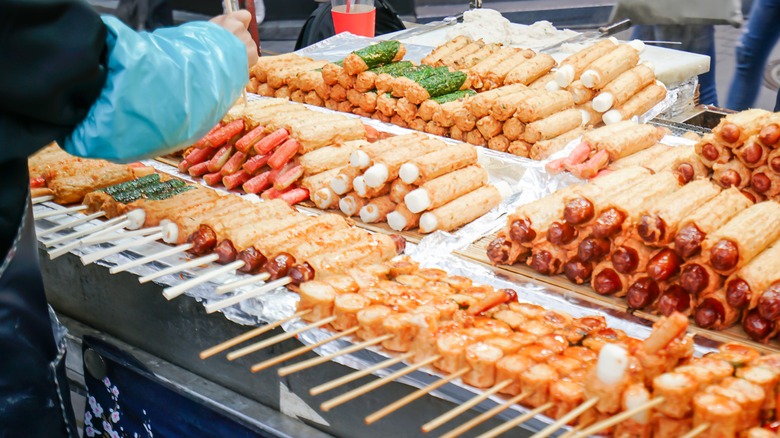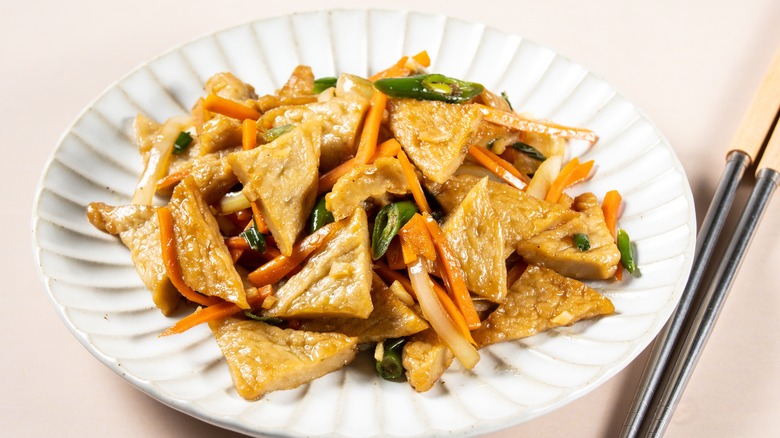In South Korea, Eomuk Is A Versatile Staple And Popular Street Food
If you ever step into a Korean convenience store, bunsik jip (snack or fast-food restaurant), or a Korean alley with street food, you will inevitably run into eomuk. The thin, battered fishcakes are found in the iconic gochujang-bathed tteokbokki, artfully weaved on wooden skewers that are commonly submerged in soup or stir-fried as a banchan.
Eomuk come in a plethora of shapes, sizes, colors, and flavors; you can have one coated in a batter of finely minced carrots and scallions or a plain-as-you-like brown fishcake. Made of a blend of finely ground whitefish, flour, sugar, salt, starch, and vegetables, eomuk is as carb-y as it is full of protein. In terms of flavor, eomuk are rather mild, most commonly made from whitefish like cod, pollock, snapper, and plaice, though sometimes squid and shrimp are added into the mix. Attempting to make eomuk at home would be a gargantuan task, akin to trying to DIY hot dog wieners, so if you're curious to sample one, we suggest you first visit a Korean restaurant or H Mart to find the stuff.
How eomuk came to be
Many believe that eomuk is a Korean spin on Japanese oden, but there are earlier records showing the Korean origins of this fishcake. According to a 2020 issue of KOREA Magazine, a 1719 publication of Jinyeoneuigwe (Historical Records of the Palace), describe eomuk as an aristocratic dish of thinly sliced fish meat that is ground up and mixed with starch, sesame oil, and soy sauce. This recipe is not unlike the eomuk we eat today, though this version was molded into chunks, flattened, steamed, and topped with soy sauce and pine nuts. While this is still a way in which it's served in Korea, its evolution into street food means today they are more commonly fried — as croquettes, stuffed into peppers, or coating sausages.
As the dish reached the masses, the way it was prepared also changed — now being processed more by machine than hand. Rather than whole pieces of sliced fish, today, it's made from about 50% to 60% minced or pureed white fish (although higher-grade eomuk products are available). In eomuk factories, white fish are gutted, deboned, and pureed before being steamed into a slurry, mechanically ground, and passed through a sieve. Modern eomuk shops use this cooked fish paste as a dough base, to which other seasonings, vegetables, and starches are added to be chilled (for optimal chewiness) and deep-fried into bread-battered balls or sheets.
How eomuk is eaten
Eomuk is an essential ingredient in many Korean dishes. Similar to imitation crab in flavor, this subtly sweet and fishy treat adds protein and texture to any soup. Although there are countless forms of eomuk, the most popular kind comes in a thin sheet, around 2 to 3 mm thick. This eomuk is either sliced into smaller pieces to be stir-fried as banchan, or used in classic Korean dishes like kimbap and japchae. You'll also see it as eomuk tang, where large pieces of this sheet are folded and woven into large wooden skewers submerged in anchovy broth. These fishcake skewers are a classic snack found in Korean fast-food joints, almost always paired with spicy tteokbokki.
You'll find eomuk in a variety of other shapes, such as tubes, balls, or nuggets, and if you're having stir-fried eomuk in a banchan or in kimbap, you won't need any dipping sauces. However, for something as light as eomuk tang, where the fishcakes are in a plain anchovy broth, Koreans usually dip them in a classic dip made of soy sauce, Korean chili powder (gochugaru), chopped green onions and jalapeños, garlic, sweetener, and sesame oil and seeds. This dipping sauce accompanies just about any boiled or steamed snack that needs extra saltiness.
So if you spot any iteration of these battered whitefish delights that are centuries in the making, don't miss the opportunity to try them out.


